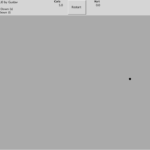Kyma Tools (10)
Layout:
Showing 1-10 of 10
-
Embedded Markers as Audio Triggers
Updated version! Leverage embedded markers in audio files to create an array of time stamps that can be used inside "tripWires: #()" array as timing gate for sample-accurate triggering. Link to my initial Q&A question: https://kyma.symbolicsound.com/qa/6074/markers-as-audio-sample-triggers?show=6077#a6077 Steps for using 1. Embed markers in audio 2. Run the Capytalk in this file and write down the times that are shown in debug window. 3. Either copy the times into "tripWires: #()" array, used as gate for audio sample trigger (so you can select which ones to use) OR simple use (1 ramp: !Length s) tripWIres: #(markers asArray) 4. Playback. sounds are triggered exactly when they should be. no matter how much time stretching you do on the audio file. Examples show how it's done. Read MoreNotes : version 1.2.
- 12uploads
- 0questions
- 0answers
-
Genetic Algorithm Tool
This tool implements an algorithmic composition technique based on Genetic Algorithms as originally developed by John Holland. It does not create a composition, but drives a process over time whose evolution may be sonically interesting. As with many things, it is all about the journey and not the destination, so interesting sonic events can occur as the algorithm moves toward its goal state. This goal state and many parameters may be changed over time. Genetic Algorithms are a type of heuristic search, where a large search space is explored via a generate-and-test procedure. At each generation, a population of chromosomes are evaluated based on some fitness criterion. Based on this fitness criterion, pairs of chromosomes are selected for mutation and crossover, then added to the population. In the context of heuristic search, this process continues until a suitable (but not necessarily optimal) solution is found. In our case, the goal is to hear the evolution. Chromosomes are a collection of pitches (6) which are played at each generation, with the fitness criterion being consonance: defined as a relationship to the reference frequency that is closest to ratios of small integers, with smallest integer ratios such as 2:1 and 3:2 being ideal. This can also be inverted to seek dissonance. As in the heuristic search application, selecting pairs of chromosomes for mutation and crossover also occurs. As expected, this process will converge on consonance at some point, but increasing the mutation and crossover probabilities as it runs can cause it to wander away, or the goal could be changed to dissonance for a different sonic direction. Another way to drift away is by changing the reference frequency, either in the tool, or following some external source. This tool does not create sounds but changes event values as it runs along with an associated multigrid. !Freq1 !Freq2 !Freq3 !Freq4 !Freq5 !Freq6 event values reflect the contents of the 6 elements of each chromosome as it evolves, and are presumed to be associated with 6 tracks of an associated Multigrid. !RefFreq is used as a reference when evaluating the fitness of each chromosome and can be changed externally or in this tool. If !RefFreq is changed, the genetic algorithm tool with reorient toward the new value, i.e. the !FreqN event values will begin to seek the new target. !Level1 !Level2 !Level3 !Level4 !Level5 !Level6 simply control the levels of each track by convention. The associated Multigrid tracks are selected and triggered as appropriate during evolution. The display area shows a column for each chromosome with each of the 6 frequency components represented by a red bar at a height corresponding to its frequency, with brighter red indicating instantaneous fitness of a particular chromosome column. The yellow arcs indicate the pairs of chromosomes selected at each generation. The green box indicates the chromosome chosen to "play" at each generation, and is randomly chosen from among the more "fit" chromosomes that are the products of a previous generation. An associated Multigrid is provided as an example (GA-test.mgd). For pedagogical purposes, this Multigrid is fantastically boring, simply playing a voice using the !FreqN values described above. You can, of course, do anything you'd like with these event values to savor the emergent sonic experience. See GA.kyt to get started. Read More
- 2uploads
- 0questions
- 0answers
-
Quad-Graphical Envelope
Tool with 4 graphical ADSR envelopes which modify the desired EventValues in real time. Maximum Value of the Attack/Delay/Release stages can be modified. The names of the related EventValues can also be modified.
- 4uploads
- 0questions
- 0answers
-
First order ambisonic encoder/decoder 2.5a
** For more information about how to build or adjust ambisonic tools, please download the tutorial over here: https://kyma.symbolicsound.com/library/kiss2019-ambisonic-workshop/ These are encoders and decoders for first order ambisonic type B. It also contains encorder that allows you to pan any sound into ambisonic space, and a space controller that allow you to rotate the whole ambisonic space the way you want. It also contains ambisonic decoders for multichannel 2D space, 3D space, and binaural for headphone for you to build your VR sounds. Have fun!! What's new in 2.5a Select "LowerCost" in BinauralPanner for lower cost binaural ambisonic decoding. What's new in 2.5: !W is available as a variable instead of constant right now. You can lower !W value to make the sound spread out or raise to sound centered (or mono). What's new in 2.0: Support Ambisonic Type A and Ambix file format. Provide Ambisonic Type A to Type B and Ambix translators. Provide space controller in all 2D, 3D, including binaural decoders. One recording example for testing. Read More
- 2uploads
- 0questions
- 0answers
-
Convert single column Data Text File(s) into mono Audio File(s)
Two Kyma Scripts to convert first column of data file(s) (e.g. .txt) into audio file(s) (amplitudes as samples). Each row of data becomes one sample of an audio file. Works for a batch folder of text files! Read More
- 12uploads
- 0questions
- 0answers
-
Simulated Annealing Tool
This tool implements an algorithmic composition technique based on simulated annealing. Simulated annealing belongs to a class of probabilistic algorithms where large search spaces can be explored using a generate and test approach, and an optimal solution is not required. In a musical context, the initial state is an arbitrary set of pitches. These pitches are tested according to a criterion, such as relative consonance, then microtonally perturbed and re-tested according to this same criterion. This process continues until a goal state or some arbitrary practical limit is reached. Thus, the resulting music is an emergent property of the search process. Unlike optimization problems where the goal is a solution, algorithmic composition using simulated annealing is all about the journey and not the destination. !Freq1 !Freq2 !Freq3 !Freq4 event values reflect the contents of the 4 elements of each generation as it progresses, and are presumed to be associated with 4 tracks of an associated Multigrid. !RefFreq is used as a reference when evaluating the 4 frequencies of an iteration and can be changed externally or in this tool. !Level1 !Level2 !Level3 !Level4 simply control the levels of each track by convention. The associated Multigrid tracks are selected and triggered as appropriate during the process. An associated Multigrid is provided as an example (SAT-Example.mgd). This example is naturally quite simple. It will "discover" something like a major chord around generation #55, then stop the perturbation process for the remaining generations. If you find major triads disturbing, you can then change the reference frequency, and more wandering will occur. You can of course use any sounds in your multigrid, and there is infinite musical exploration available to you in the tool. Read More
- 2uploads
- 0questions
- 0answers
-
 Kyma Pong
Play Carla vs. Kurt in an exciting Pong game :D
Kyma Pong
Play Carla vs. Kurt in an exciting Pong game :D- 5uploads
- 0questions
- 0answers
-
Concatenate A Folder of Files into One Audio File
"Concat A Folder" Sound takes a folder of audio files and concatenates them all into one long audio file. This is a batch process, and happens out of real time. This will work for folders with stereo or mono files, but you will need the samplerate to match. Read More
- 12uploads
- 0questions
- 0answers
-
ASCII keyboard tool (keypad.pci)
keypad.pci is a Kyma Tool that converts the Qwerty computer keyboard into Hot Values inside Kyma. The two Hot Values are !KeyBoard and !KeyPad. This just lets you harness your ASCII keyboard as a controller with Kyma. The only note about keypad.pci is that the window needs to be highlighted (in front) in order to work properly. Read More
- 12uploads
- 0questions
- 0answers
-
 Sound Examples for LinnStrument
Examples that can be played on the LinnStrument (or other expressive controller). Includes Sounds for switching on/off the LinnStrument LEDs and a Tool that switches cells on and off according to Conway's Game of Life rules.
Sound Examples for LinnStrument
Examples that can be played on the LinnStrument (or other expressive controller). Includes Sounds for switching on/off the LinnStrument LEDs and a Tool that switches cells on and off according to Conway's Game of Life rules.- 15uploads
- 0questions
- 0answers